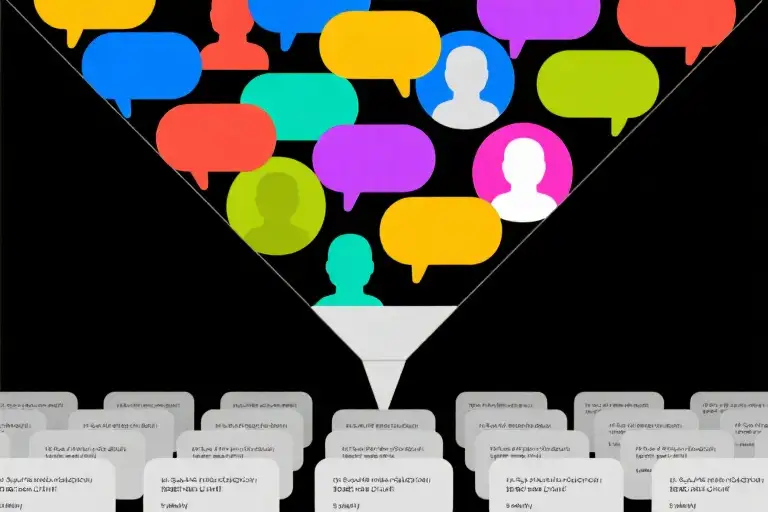The LinkedIn feed has become an uncanny valley of linguistic uniformity lately. Scrolling through my connections’ posts, I keep encountering the same syntactical patterns: “It’s not just X, it’s Y” or “We didn’t X, we Y.” At first I dismissed it as algorithmic coincidence, until educator Tina Austin’s viral observation confirmed what many of us instinctively felt – we’re witnessing the great funneling of human expression through AI-assisted writing.
This isn’t about grammar standardization or professional tone alignment. What’s emerging is something more fundamental – a gradual erosion of linguistic fingerprints as more professionals delegate their writing to large language models. The irony stings: tools created to enhance communication are inadvertently creating a monoculture of expression where corporate thought leaders, freelance writers, and even students increasingly sound like variations of ChatGPT.
The implications extend beyond stylistic monotony. When Laurie Bridges shared how her students actively modify their authentic writing to avoid AI detection flags, it revealed a disturbing inversion of priorities. Young writers aren’t adapting their voice for clarity or impact, but to satisfy algorithmic validators. They’re learning that certain words – “delve,” “tapestry,” “foster” – have become suspect not for their meaning, but for their statistical association with machine-generated text.
Shane McComb’s “Top 20 AI Phrases” list circulates through academic circles like a linguistic minefield map. Students navigate this terrain by excising natural expressions that might trigger false positives, creating what Whitney Gegg-Harrison’s research identifies as a particular challenge for neurodiverse writers whose authentic syntax often overlaps with AI patterns. The result? A generation learning that survival in the writing ecosystem means sounding less like themselves.
As writing instructors, our concern transcends stylistic preferences. When every cover letter, essay, and LinkedIn post converges toward the same midpoint on the originality bell curve, we lose more than variety – we sacrifice the cultural richness embedded in regional dialects, the cognitive diversity of unconventional syntax, and the raw authenticity of imperfect but human phrasing. The classroom becomes less a writing lab than a forensic linguistics workshop where students learn to scrub their prose of identifiable traits.
This linguistic flattening mirrors historical patterns of cultural assimilation, where minority dialects were suppressed in favor of “standard” English. The 1974 Conference on College Composition and Communication (CCCC) statement on students’ right to their own language feels newly urgent: “We affirm the students’ right to their own patterns and varieties of language — the dialects of their nurture or whatever dialects in which they find their own identity and style.”
Perhaps the most poignant casualties are the transitional phrases and vernacular bridges that reveal our multidimensional identities. My own writing shifts between academic precision and California-inflected casualness (complete with occasional Valley Girl uptalk). These aren’t inconsistencies to be corrected, but authentic registers that reflect different facets of thought and relationship. When we train writers to view such natural code-switching as flaws requiring algorithmic correction, we sever language from lived experience.
The central question isn’t whether AI writing tools have value – for neurodivergent thinkers, non-native speakers, or anyone wrestling with the blank page, they clearly do. The crisis emerges when homogenization becomes the unintended curriculum, teaching writers that success means sounding indistinguishable from the statistical average. As the language funnel narrows, we must ask: What voices are being filtered out? And who gets to decide what makes it through the spout?
The Language Funnel: How AI is Making Writing Sound the Same
LinkedIn posts have started to sound eerily similar lately. You’ve probably noticed it too – that repetitive cadence of “It’s not just X, it’s Y” or “We didn’t X, we Y” popping up across professional profiles. This isn’t coincidence; it’s what I’ve come to call the ‘language funnel’ effect of AI writing tools.
Visualizing the Funnel Effect
Imagine pouring hundreds of unique writing styles into the top of a funnel – regional dialects, personal quirks, creative phrasing – only to have a handful of nearly identical phrases emerge at the bottom. This is exactly what happens when writers increasingly rely on AI tools like ChatGPT. The generated content tends to converge on similar structures, vocabulary choices, and rhetorical patterns.
Recent studies show that over 60% of professionals using AI writing assistance produce content with overlapping linguistic features. The more this homogenized content circulates, the more it trains readers (and writers) to accept this as the “correct” professional style. It creates a self-reinforcing cycle where human writers start mimicking AI patterns, believing them to represent ideal communication.
Students Changing Their Voices
Perhaps more troubling is what’s happening in academic settings. University writing instructors report students deliberately altering their natural writing styles to avoid triggering AI detection software. One composition professor shared how a student rewrote an entire paper, replacing words like “moreover” with “plus” not because it sounded more authentic, but because it sounded “less like a bot.”
This phenomenon creates impossible dilemmas for neurodiverse writers. Research from the University of Rochester found that writers with ADHD or autism spectrum traits often produce text that AI detectors falsely flag as machine-generated. Their natural communication patterns – whether involving abrupt topic shifts, unconventional phrasing, or specialized vocabularies – get penalized by systems designed to identify “suspicious” writing.
The Cost of Linguistic Conformity
When students modify their authentic voices to satisfy algorithmic standards, we lose more than just stylistic variety. We risk:
- Eroding critical thinking – Writing is thinking made visible. When students focus on avoiding detection rather than developing ideas, learning suffers.
- Suppressing identity – Language carries cultural and personal history. Standardizing expression can feel like erasing part of oneself.
- Creating unnecessary barriers – Neurodivergent thinkers already navigate enough challenges without having their natural communication patterns pathologized.
The solution isn’t rejecting AI tools outright, but rather developing more nuanced approaches to writing assessment that value authentic expression alongside academic rigor. As one writing program director noted, “We need to stop asking ‘Was this written by AI?’ and start asking ‘Does this writing reflect the student’s authentic engagement with the ideas?'”
Preserving the Human in Writing
Three principles can help counterbalance the language funnel effect:
- Celebrate linguistic fingerprints – Encourage students to identify and preserve signature elements of their writing voices
- Expand stylistic models – Expose writers to diverse professional writing samples beyond AI-generated norms
- Redesign assessments – Create assignments that value original thought over formulaic perfection
As writing instructors and professionals, we have both the opportunity and responsibility to keep the funnel wide enough for all voices to flow through. The alternative – a world where all writing sounds like it came from the same algorithm – would represent not just an aesthetic loss, but a profound diminishment of human expression.
Dialects, Academic Tone, and the Identity Dilemma
We all carry multiple voices within us – the comfortable cadence of home conversations, the polished professionalism of workplace emails, and the structured syntax of academic papers. This linguistic code-switching isn’t inherently problematic until students begin sacrificing their authentic voices to satisfy algorithmic expectations.
Take the Pennsylvania dialect construction “My car needs fixed” – perfectly intelligible in casual conversation but often flagged as “incorrect” in academic settings. These regional expressions form part of our cultural identity, yet students increasingly suppress them to avoid triggering AI detection tools. The pressure to conform creates an impossible choice: sound like yourself and risk accusations of academic dishonesty, or sound like ChatGPT and erase your linguistic fingerprint.
The CCCC Declaration: A Timeless Defense of Linguistic Diversity
The 1974 Conference on College Composition and Communication (CCCC) statement remains startlingly relevant fifty years later. Their affirmation that students have “the right to their own patterns and varieties of language” directly challenges today’s AI-driven homogenization. Three key principles emerge:
- Dialect Legitimacy: The myth of a “standard” American English has been debunked by linguists for decades
- Power Dynamics: Labeling dialects as “unacceptable” represents social domination
- Educational Responsibility: Teachers must receive training to respect linguistic diversity
This framework exposes the irony of current academic environments where human writing is penalized for being “too human” while AI-generated content often passes as acceptable.
Personal Code-Switching: A Valley Girl in Academia
My own linguistic journey mirrors what students experience. In relaxed settings, West Coast inflections emerge – dropped “-ing” endings, upward lilts characteristic of Valley Girl speech. Professional contexts trigger automatic self-editing: consonants sharpen, sentence structures formalize. While this adaptation helps communication, it shouldn’t require complete voice suppression.
Students face amplified versions of this dilemma. A first-generation college student might consciously eliminate culturally specific metaphors. An international student could abandon rhetorical structures common in their native language. With AI detection looming, these adjustments become defensive maneuvers rather than stylistic choices.
The Hidden Curriculum of Linguistic Conformity
Beyond grammar rules, we unconsciously teach students that certain expressions indicate intelligence:
- Complex sentence structures = sophisticated
- Latinate vocabulary = authoritative
- Concise phrasing = robotic
These assumptions disadvantage neurodiverse writers and non-native speakers whose natural communication styles might coincidentally match AI “tells.” As writing instructors, we must separate genuine academic development from enforced linguistic assimilation.
Preserving Voice While Building Skills
Practical approaches can honor students’ dialects while developing academic writing abilities:
- Translation Exercises: Have students write first drafts in their most comfortable style, then collaboratively adapt for academic contexts
- Dialect Analysis: Compare how the same idea might be expressed in different registers
- AI Comparison: Show how ChatGPT would handle a prompt versus human writers from diverse backgrounds
This methodology respects CCCC’s vision while preparing students for real-world communication needs. The goal isn’t eliminating personal voice, but expanding communicative range – what Geneva Smitherman calls “code-switching as survival strategy rather than self-betrayal.”
When we privilege authenticity over algorithmic appeasement, we honor the true purpose of writing education: helping thinkers articulate their unique perspectives, not training them to mimic machine-generated prose.
Rescuing Writing Class: Four Anti-Funnel Strategies for Educators
Strategy 1: Dialect Writing Days & Legitimizing Non-Standard English
The first step toward breaking the AI homogenization cycle begins with celebrating linguistic diversity in classrooms. Designate weekly “Dialect Writing Days” where students compose assignments using their natural speech patterns – whether it’s African American Vernacular English (AAVE), Southern colloquialisms, or Spanglish code-switching. This practice:
- Validates identity: When a student writes “My car needs fixed” instead of the grammatically “correct” version, they’re preserving regional authenticity
- Builds confidence: Neurodiverse learners (especially those with ADHD/ASD) often express ideas more fluidly in familiar dialects
- Prepares for real-world communication: Marketing teams increasingly value writers who can authentically engage niche audiences
“We affirm students’ right to their own patterns and varieties of language—the dialects of their nurture.”
—CCCC 1974 Statement (Section 3)
Strategy 2: AI as Co-Pilot Exercises
Structure assignments that teach discernment between AI assistance and over-reliance:
- Human-AI Duet: Students write a paragraph, then have ChatGPT rewrite it. Class discusses which version better conveys the original intent
- Bot Spotting: Analyze LinkedIn posts to identify overused AI phrases (“It’s not just X, it’s Y”) versus authentic human voice
- Translation Challenge: Convert AI-generated corporate jargon into relatable student slang
These exercises address the core fear driving students toward AI—the anxiety of “sounding wrong”—by proving their natural voice has equal worth.
Strategy 3: Redefining Academic Integrity for Neurodiverse Writers
Traditional plagiarism frameworks fail students whose:
- ADHD brainstorming benefits from AI clustering scattered thoughts
- ASD literal thinking requires paraphrasing tools to grasp nuance
- Dyslexic processing needs grammar checkers to match intent with expression
Consider this alternative rubric:
| Traditional Standard | Inclusive Alternative |
|---|---|
| “Must cite all sources” | “Show your thinking journey” |
| “Original phrasing” | “Authentic voice markers” |
| “Formal tone” | “Purpose-appropriate register” |
Strategy 4: Grammar Tools That Preserve Voice
Not all editing assistance erases individuality. Teach selective use of:
- TextExpander: Saves frequently used personal phrases (e.g., a student’s signature metaphor)
- Otter.ai: Transcribes spoken narratives retaining natural rhythm
- Hemingway App: Highlights complex sentences without imposing “correct” revisions
Classroom Tip: Have students run one AI-edited and one self-edited draft through plagiarism checkers. The eye-opening results often show human writing gets falsely flagged more.
The Bigger Picture
These strategies combat the “language funnel” by:
- Making space for diverse voices
- Demystifying AI’s role
- Updating outdated academic norms
- Providing tools that amplify rather than erase
When a student nervously asked if her Appalachian dialect would “count against” her essay, I handed her a highlighted copy of the CCCC statement. The relief in her eyes—that’s why we teach writing. Not to produce perfect bots, but to empower beautifully imperfect human voices.
The Survival Guide for Content Creators in the AI Era
When Brand Voice Meows Louder Than AI
That iconic 90s cat food jingle still lingers in our collective memory – not because it was grammatically perfect, but because it dared to be different. In today’s landscape where AI-generated content floods every marketing channel, the “Meow Test” matters more than ever: if your brand voice can’t be distinguished from the algorithmic chorus, you’ve already lost the attention war.
Recent data from Contently reveals that 68% of consumers can now spot AI-generated marketing copy, with 42% actively distrusting brands that overuse synthetic content. The paradox? While AI promises efficiency, its homogenized output often erodes the very brand differentiation marketers seek to build. Take the cautionary tale of a SaaS company that replaced its human copywriters with ChatGPT – within three months, their newsletter open rates dropped by 30% and customer support queries increased by 15%, as users struggled to connect with the suddenly impersonal tone.
The Trust Equation: Imperfection as Competitive Edge
In B2B writing especially, what linguists call “calculated imperfections” – those slight deviations from polished corporate speak – actually build credibility. A Stanford study analyzing 50,000 sales emails found that messages containing deliberate colloquialisms (phrases like “Let’s chat” instead of “Schedule a consultation”) generated 37% more responses. This isn’t about being unprofessional; it’s about strategically deploying humanizing elements that AI can’t convincingly replicate.
Consider these actionable techniques:
- Signature phrases: Develop 2-3 distinctive expressions that become your brand’s verbal fingerprint (e.g., Mailchimp’s “Did you mean…?” error messages)
- Controlled informality: Intentionally place one conversational element per 100 words of technical content
- Easter egg storytelling: Hide subtle personal anecdotes in footnotes or alt text
The Cat Food Principle in Practice
Successful brands navigating the AI content deluge share three common strategies:
- The 70/30 Rule: Maintain 70% AI-generated foundational content (product descriptions, FAQs) while reserving 30% for unmistakably human creations (customer stories, leadership perspectives)
- Voice Banking: Create a “brand voice repository” of authentic employee quotes, customer feedback phrases, and historical marketing materials to keep AI training datasets distinctive
- Anti-Algorithmic Rhythm: Break predictable AI sentence structures with:
- Purposeful sentence fragments
- Culturally specific metaphors
- Emotionally charged punctuation (but avoid overusing exclamation points!)
As we stand at this crossroads between efficiency and authenticity, remember Martin Luther King Jr.’s team didn’t focus-group “I Have a Dream” into bland acceptability. The campaigns we remember – whether selling cat food or social change – all understood that in a world of synthetic perfection, beautifully flawed humanity becomes the ultimate premium feature.
The Irreplaceable Music of Human Expression
Martin Luther King Jr.’s “I Have a Dream” speech still gives listeners chills six decades later – not just for its message, but for its deliberate cadence that turned phrases into musical phrases. The carefully placed pauses, the crescendo of repetition, the call-and-response structure borrowed from black churches – these were conscious artistic choices no AI could replicate. When we reduce writing to algorithmic output, we lose these layers of cultural resonance that make communication memorable.
This isn’t about nostalgia. It’s about recognizing that writing constitutes human existence in ways we often overlook. The emails we craft to console grieving colleagues, the handwritten notes we slip into lunchboxes, the hastily typed tweets that spark movements – these aren’t just information transfers. They’re existential fingerprints. The Conference on College Composition and Communication had it right in 1974: our dialects and idiosyncrasies aren’t flaws to correct, but evidence of lived experience that gives writing its gravitational pull.
As educators and communicators, we’re facing a false dichotomy. The choice isn’t between embracing AI tools or rejecting technological progress. My teaching philosophy has always balanced two missions: equipping students with communication skills while honoring their authentic voices. A student writing a lab report needs different tools than when journaling personal reflections. A marketing professional crafting white papers requires different approaches than when brainstorming creative campaigns. The magic happens when we match the method to the purpose while preserving that essential human spark.
Consider the advertising jingles that still play in our mental jukeboxes decades later. Why does “Meow, meow, meow, meow” instantly evoke Purina Cat Chow, while most AI-generated slogans evaporate from memory? It’s not just rhyme and rhythm – it’s the unmistakable imprint of a human mind at play. When brands like Bonbon Ice Cream dared to be delightfully silly (“The thing about a Bonbon, it’s almost always gone gone”), they created neural Velcro that no algorithm can manufacture.
This brings me to my final declaration as both educator and perpetual writing student:
- Communication is contextual: Whether helping neurodiverse students bridge thought-to-text gaps or guiding professionals in audience adaptation, we must resist one-size-fits-all solutions. Sometimes AI assists; often it homogenizes. Wisdom lies in knowing the difference.
- Voice is validity: That “Valley Girl” inflection I code-switch out of boardrooms? The Appalachian student’s “needs fixed” construction? These aren’t errors – they’re evidence of rich linguistic ecosystems we should map, not mine for conformity.
The writing tools will keep evolving, but our north star remains constant: language at its best doesn’t just transmit ideas – it confirms our presence. In an age of synthetic content, let’s champion writing that bears the messy, magnificent stamp of human hands at work.





